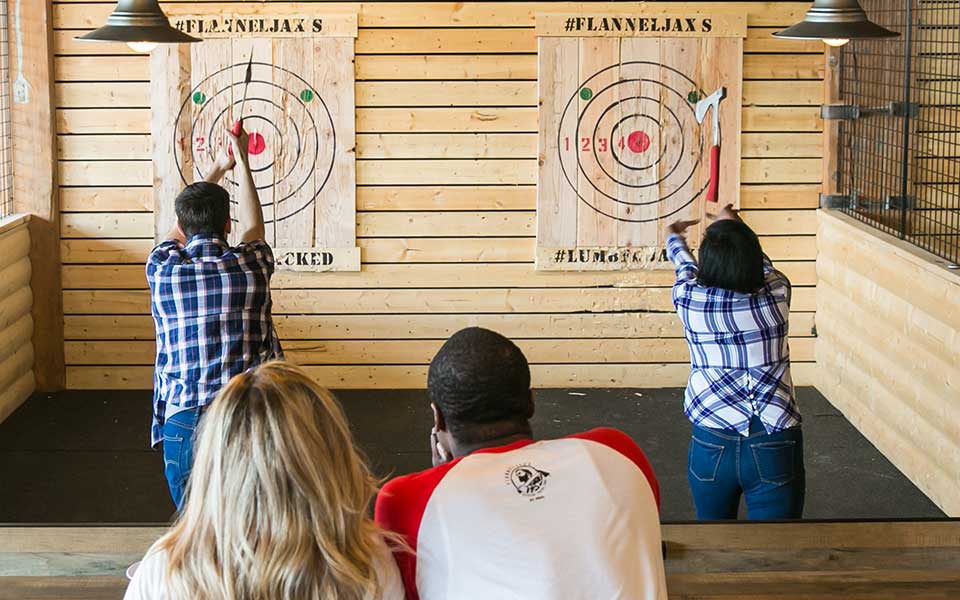Study the Axe Throwing Denver Scene: What You Required to Know
Study the Axe Throwing Denver Scene: What You Required to Know
Blog Article
The Enjoyable of Axe Throwing: How This Sporting Activity Combines Skill and Adrenaline for a Good Time
Axe throwing has arised as an astounding sport that masterfully links the demand for specific ability with the thrill of adrenaline, offering individuals a one-of-a-kind and engaging experience. The act of tossing an axe in the direction of a target demands focus and method, all at once fostering an environment of camaraderie and pleasant rivalry.
The Origins of Axe Throwing
Axe tossing, a recreational activity that has gotten significant popularity in recent years, traces its roots back to old times. The earliest documents of axe usage in affordable contexts are found among the Celts and Vikings, who threw axes for sporting activity as well as in battle training.
Middle ages European warriors, particularly during the Middle Ages, exercised axe throwing as component of their martial training. The Francisca, a kind of throwing axe utilized by the Franks, ended up being iconic for its harmful accuracy. This standard weapon was developed to be tossed at opponent shields and shield, showcasing its twin energy in both sporting activity and fight.
In even more current background, axe tossing saw a rebirth in the logging camps of North America in the 19th and 20th centuries. Lumberjacks would participate in friendly competition, testing their precision and toughness by targeting at wood targets. This advancement from a survival ability to a recreational activity has actually paved the method for its contemporary revival, with devoted locations and leagues now celebrating the sporting activity globally.
Equipment You Need
Understanding the abundant background of axe throwing enhances the appreciation of the sporting activity's modern-day version. Central to this thrilling activity is the equipment, which is vital for both safety and efficiency. The main tool is, certainly, the axe. For affordable and entertainment axe tossing, one of the most commonly used type is the hatchet, commonly weighing between 1.25 to 2 pounds with a deal with size of about 16 inches. The axe needs to have a sharp, properly maintained blade and a handle made from durable wood or composite product, ensuring a good grip and equilibrium.
Just as important is the target. Policy targets are built from wood, with softwood ranges like ache or cottonwood being preferred for their ability to hold the axe and absorb. The target is generally separated right into five concentric circles, each with a certain factor value, to help with scoring.
Safety and security gear, though commonly ignored, is essential. Safety handwear covers can enhance grasp and protect against blisters, while closed-toed shoes are a must to protect feet from dropped axes (axe throwing denver). A well-lit, roomy throwing location, complete with security obstacles, ensures a controlled setting where individuals can focus on sharpening their abilities.
Fundamental Techniques Described
Mastering the basic methods of axe throwing is essential for both security and proficiency. The leading hand must be placed straight below the axe head, while the non-dominant hand supports the end of the handle.
Following, concentrate on the position. Stand with your feet shoulder-width apart, ensuring your body is stabilized. Your leading foot needs to be somewhat onward, straightening with your target. This positioning aids in maintaining security and routing power properly in the direction of the target.

Security First
Ensuring safety check this site out and security in axe throwing is paramount to developing a satisfying and injury-free experience. A well-designed axe throwing facility features clear separations between tossing lanes, strong backgrounds to capture stray axes, and non-slip flooring to prevent accidents.
Benefits of Axe Throwing
Axe tossing deals a myriad of benefits that expand past basic recreation. Physically, it supplies a full-body workout, involving muscles in the arms, shoulders, back, and core. The repetitive activity of throwing the axe additionally improves hand-eye coordination and great motor skills. For those aiming to enhance their overall physical fitness, axe throwing can act as a engaging and vibrant kind of exercise.
Mentally, axe tossing calls for accuracy, strategy, and focus, making it an outstanding means to develop cognitive skills. The concentration required to hit the target can act as a form of mindfulness, enabling participants to remove their minds and reduce stress. This psychological involvement can be especially valuable in helping people establish much better analytic skills and mental resilience.
Socially, axe throwing is frequently appreciated in group setups, fostering team-building and friendship. Whether as component of a corporate event or a laid-back trip with close friends, the sporting activity urges communication and partnership. Furthermore, the communal experience of finding out and boosting with each other can reinforce connections and produce my latest blog post long lasting memories.
Final Thought

The earliest documents of axe usage in affordable contexts are located amongst the Celts and Vikings, that threw axes for sport as well as in combat training. Release the axe when your hands are roughly at eye level, enabling the axe's natural rotation to guide it in the direction of the target.
A well-designed axe throwing center attributes clear demarcations between throwing lanes, strong backdrops to capture roaming axes, and non-slip flooring to stop mishaps. Participants should be instructed on the appropriate method to toss the axe and handle, stressing regulated, purposeful activities over forceful throws.
In recap, axe tossing stands out as a sporting activity that masterfully incorporates adrenaline, accuracy, and skill.
Report this page